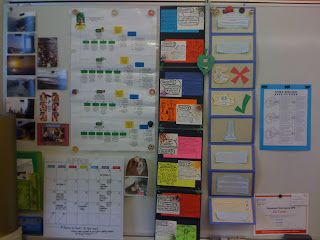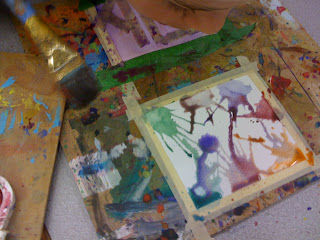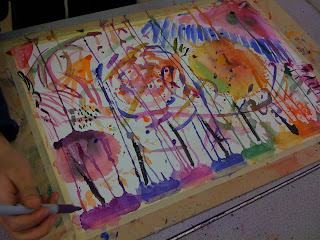In Semester One, I shared Art 9 with the other Art Teacher at my school. She divides her art courses into 4 project areas; Drawing, Painting, Sculpture and Design. In the first semester, for the design component of the course, we did Tissue Paper Windows. It was my first time teaching this particular lesson, and I found many more obstacles and difficulties with this project than I did reward.
This project was all about designing a simple composition focusing on the positive and negative space, the shapes that make up an object as well as refining some controlled fine motor skills. The process of designing the image with the stained glass effect of the thick black lines is not a bad process and certainly teaches the students some great lessons. The finished products were mostly wonderful, but it very easy to make a mistake, and using the tissue paper was, of course, a very delicate material. Here are pictures of some of the finished student pieces that turned out really nicely.
 | |||
|
 |
 |
 |
- Size: If I were to do this again, I would do it MUCH smaller. I had them working on large pieces of black Mayfair paper, and it just took took long.
- Simplicity: I would emphasize the importance of keeping the image and the design simple. The simpler the shapes, the nicer the end product was. The majority of peices that did not turn out well were quite complicated, and had too much going on.
- Thick lines: Keeping as much of the black paper as possible, and keeping your lines thick is keep to adding the tissue paper. Many students went too thin with lines, and this caused many problems. When they were cutting the black spaces out, the exacto knifes would tear the lines if they were too thin. Secondly, when they were gluing on the tissue paper into the empty spaces, the thin lines gave very little space for error, and so their tissue paper had to be added on very carefully.
- Stress versus Success: There were so many students who experienced frustration and stress over this assignment and normally, I would say a little frustration is not necessarily a bad thing, but combined with the fact that there were so few students who felt that feeling of pride and success in their finished product, is it worth it?
Notan Designs
So, second semester, the other art teacher and I were no longer sharing the course. I stuck with her structure of the course, but, I decided to switch it up a little bit. I wanted a project that still stuck with the original "design" objectives, but something that more students could find success in, and more could find a challenge. The wonderful world of Pinterest led me to the Notan Design project.
I began the lesson with this instructional video that I found on an elementary art teacher blog; Art. Paper. Scissors. Glue!
Click on the following link to check out the video: Notan Design Blog Post and Video
 | |
| Finished product! |
Food For Thought:
- Supplies. I really need to figure out a way to keep track of our supplies. During this project two of the most important supplies, glue sticks and scissors, went missing. Students were having to share scissors, and at one point we only have two glue sticks for a class of 25! How do we keep track of our supplies in the art room? How do we encourage students to take care of the supplies we have, for example, returning glue sticks without caps? Any suggestions?
- Challenge: This project definitely was not as challenging as the previous terms design project. Some students completed this project very quickly, without feeling the need to challenge themselves at all. Others really took the time to create a challenging composition. Both levels turned out nicely, but I am not sure if the easier route that some students took rests well with me. How can I take a fairly simply project idea, and instill the desire to challenge oneself within my students? Maybe I just need to keep looking for the right design project?


















































